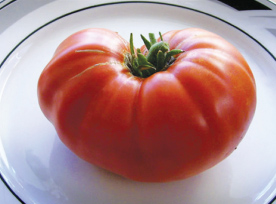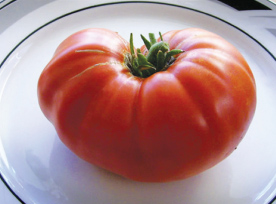A few simple tips to get great big results in the garden this year.
There is nothing better in the summertime than vine-ripened, home-grown tomatoes. Tomatoes love heat and sunshine, and despite our short growing season, Utah has the perfect climate for growing large, healthy plants that can start producing tomatoes before 4th of July picnics. But, like any venture that involves many complex variables it helps a great deal if you do not rely on chance or luck to get the results you hope for.
Utah Stories Youtube video on How to Supersize Your Tomatoes has been watched nearly 90,000 times. See for yourself my own Sugar House garden and how Keeks (my golden retriever) and I produce giant tomatoes in my back yard every year.
The three biggest factors in growing healthy tomato plants are soil conditions, sunshine and healthy, well maintained disease free plants. The most important, and most neglected aspect of successful gardening is soil condition.
There are three basic questions you need to ask in considering your garden’s soil:
1) is the soil too loamy or too sandy?
2) Is it too acidic or too alkaline?
3) Is there a nutrient deficiency?
Soil conditions vary greatly in the valley, but there are two simple tests you can conduct to ascertain soil quality. First dig a 14 by 14-inch square, four inches deep and pat down the ground inside the hole. Then fill the square with water. If the water isn’t gone in one hour, your soil is too loamy (has too much clay content) and you need to till enough sand and pearlite into your soil until it passes the test. If the water drains within 10 minutes, the soil is too sandy and you should add peat moss, mulch or steer manure.
Experts also recommend conducting a nutrient profile to understand both the pH level and a measurement of the nutrients present in your soil. I’m not an expert nor a chemist, and luckily where I live (in Sugar House) we have naturally great soil, so I haven’t done this, but I have learned the basics of botany, and what I’ve learned contradicts conventional wisdom, which is that “organic” gardening is the only way to go.
All plants require 16 essential nutrients in order to thrive. If your soil is deficient in just one of these nutrients, and you are growing without fertilizer or mineral nutrients, the deficiencies will appear in your plants. The most important required nutrients are nitrogen, phosphorus, and potassium. Secondary nutrients include calcium, magnesium and sulfur. Plants also require trace amounts of boron, copper, iron and zinc. Any one mineral deficiency will manifest in your plants in the form of yellow tips on the leaves, purple leaves, curled leaves, lack of fruit, or other deformations. Sadly, most of the tomato plants I see around my neighborhood are literally starving for the nutrients they require.
Through studying botany and plant health I’ve learned that “organic gardening” is actually a misnomer. Organic means “carbon based.” Carbon is not a nutrient plants require because plants take their carbon from the air, in the form of carbon dioxide. Tomatoes take neither carbon, nor “organic” material from the ground. Plants are not cannibals; they can’t eat decaying plants. Only after the plant matter or carbon bonds have broken down into inorganic (non-carbon) compounds can your new plants obtain the nutrients they require to thrive.
If you have time to wait for all the organic matter you compost into your soil to decompose then organic gardening can be moderately successful. But I have yet to meet an organic gardener who doesn’t use additives, producing amazing results. And I would love someone to prove me wrong in this area.
I don’t use “organic fertilizer” because I know it’s a fallacy. Whether you use ground-up egg-shells or bone meal, or calcium phosphate to provide your plants with the small amounts of calcium they require, you plants can’t tell the difference and they won’t taste better if they are starved of one of the essential nutrients they require.
If you use the proper amounts of fertilizer, you remove much of the guess work, the luck and the hope that your garden will succeed. Carefully weigh pre-plant fertilizer and till into soil before you plant your seedlings, grow all plants in organized grow-beds, then feed plants every week for the first six weeks.
If you still cringe at the idea of purchasing a bag of granular fertilizer, the very best alternative is steer manure. Even better is to create custom “garden tea” putting steer manure and other additives (such as worm casings) into cheesecloth adding oxygen through an air pump. Steer manure is unpleasant to work with, worm castings are excellent, but only if you can take the time to make “tea.”
So now you know: I’m done hiding my fertilizer in the closet. I’m coming out: I love my fertilizer — but only used in proper quantities, by carefully measuring all amounts you add to your garden.
More Information: Utah Stories has produced a video called “How to Supersize Your Tomatoes” which has received over 70,000 views on YouTube. Check it out on
Where to buy the best tomato plant seedlings: Utah Stories highly endorses Lambert Floral at 3870 South Redwood Road for tomato plants. Lambert’s selection is huge and their prices can’t be beat in town. §







